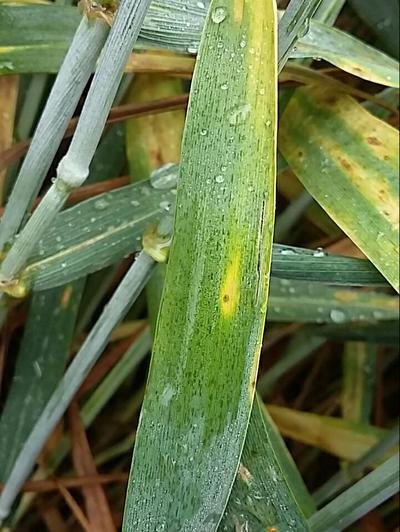Tan Spot
Pyrenophora tritici-repentis
Fungus
In a Nutshell
- Tan-brown lesions with yellow borders on leaves.
- Lesions expanding from tip to rest of the leaf.
- Pink or reddish or black colored grains.
Can also be found in
Symptoms
Symptoms can be manifested as necrosis or chlorosis or both on leaves. Tan brown, necrotic flecks appear on the upper and lower side of leaves first. They later expand into lens-shaped, tan lesions with pale green or yellow chlorotic borders of variable size. The center of the lesion can dry out and become grayish. In high humidity environments with moist leaves, the lesions display dark centers. Initial spots can coalesce into large blotches. This leads to death of leaves and defoliation of the plant. The pathogen may cause a pink or reddish staining of the grains (red smudge) or, in association with other fungi, black discoloration. However, glumes are not affected.
Recommendations

Organic Control
Use balanced fertilization to promote the settlement of antagonistic microorganisms in the soil. Organisms like Alternaria alternata, Fusarium pallidoroseum, Acinetobacter calcoaceticus, Serratia liquefaciens, and white yeasts compete with the tan spot fungus and satisfyingly reduce its occurrence.

Chemical Control
Always consider an integrated approach with preventive measures together with biological treatments if available. Foliar sprays of fungicides based on pyraclostrobin, picoxystrobin, propiconazole and prothioconazole have shown high efficiency against tan spot.
What caused it?
The symptoms are caused by the fungus Pyrenophora tritici-repentis. During the winter it survives on wheat straw or on seeds. Spores are formed and released after maturation during the spring, and dispersed by wind and water splashes. Due to their large size only over short distance. They infect the lower leaves, where they develop and produce further spores that spread the disease to the upper foliage and to other plants. Necrotic and chlorotic symptoms in plants emerge due to the production of toxins by the fungus, a process that in part depends on light. The production of spores is favored by humidity above 95%. Secondary infection is favored by leaf wetness, high relative humidity and temperatures above 10 °C for 2 days. The optimum temperature for tan spot spreading is 20-25 degrees.
Preventive Measures
- Buy certified seeds, as the fungus is frequently transmitted by infected seeding material.
- Grow resistant varieties if available.
- Use a wider spacing between your plants to hinder fungal growth.
- Thorough tilling after harvest reduces the risk for tan spot significantly, as the fungus is sensitive to competing microorganisms in the soil.
- Crop rotation with non-host plants such as mustard, flax, crambe, or soybean every second or third year is recommended.
- Monitor the plants carefully between shoot and inflorescence stages.
- Plow and destroy all plant residues after harvest.
- Use balanced fertilization to enhance plant resistance.



